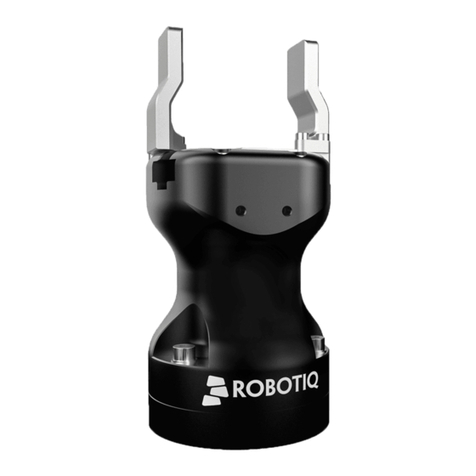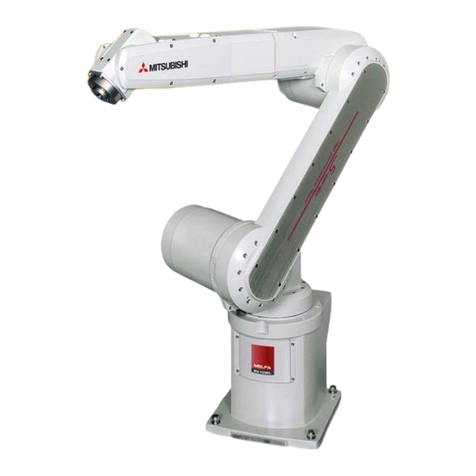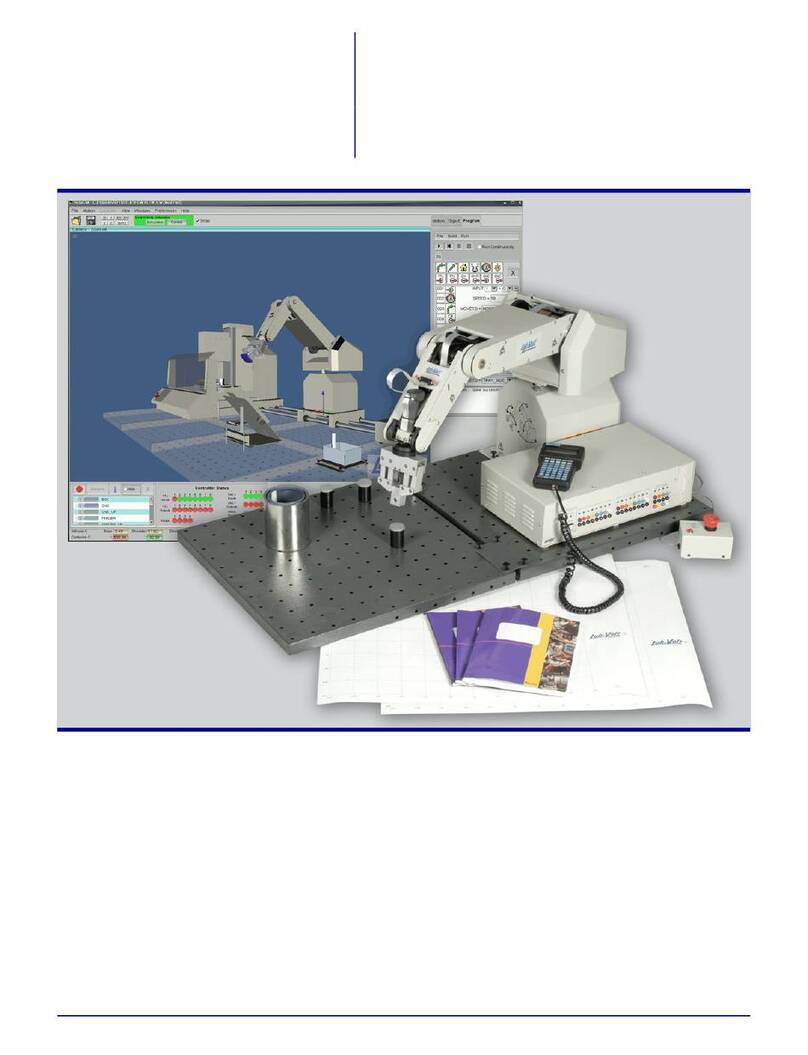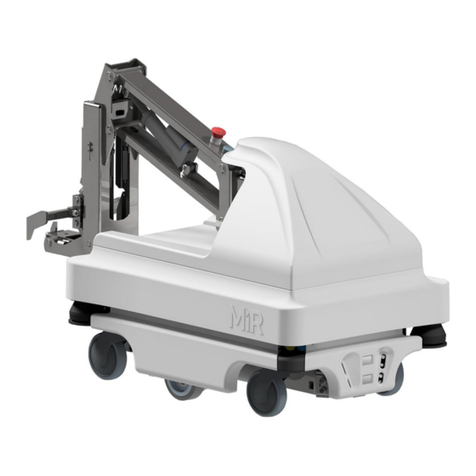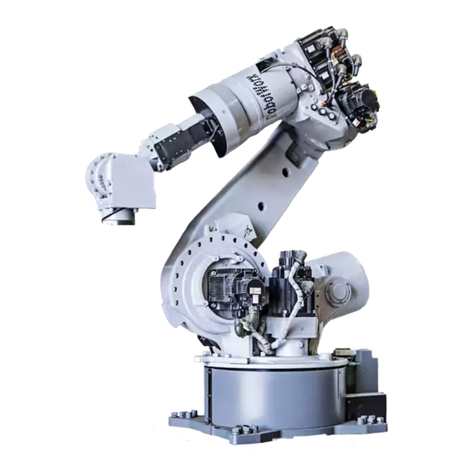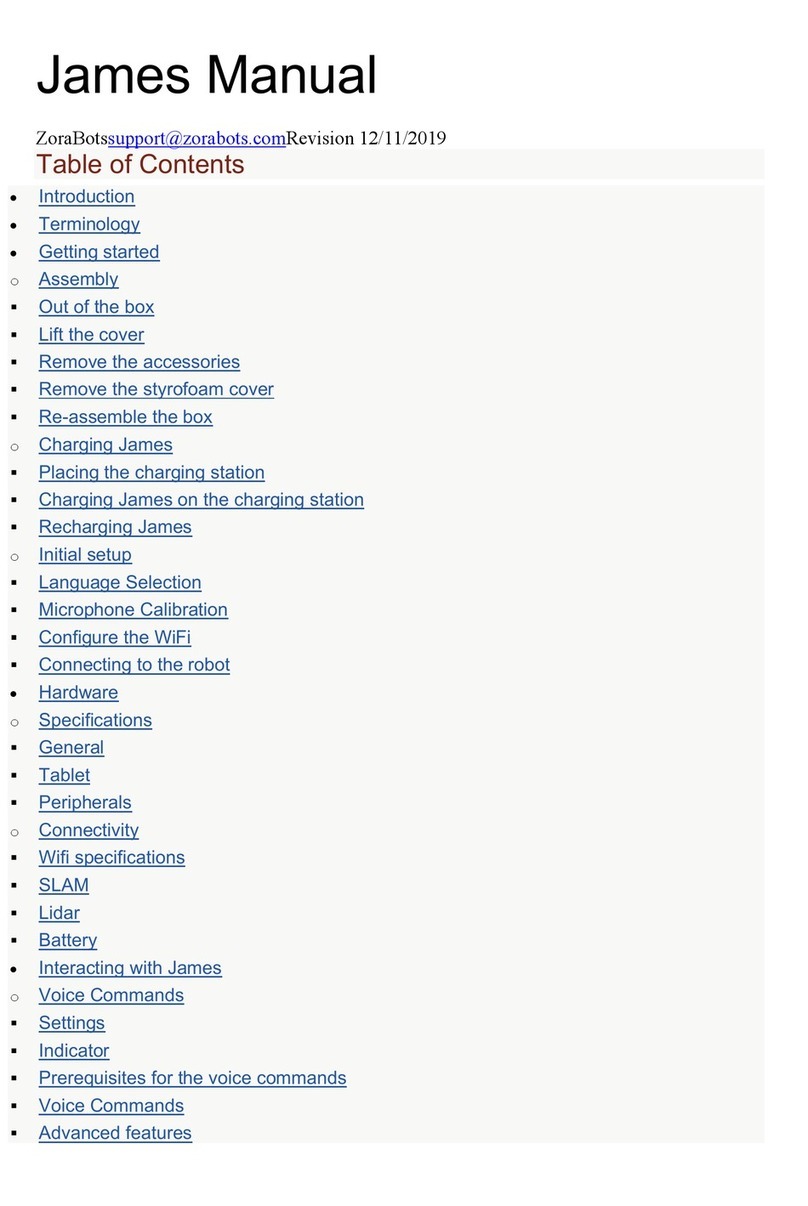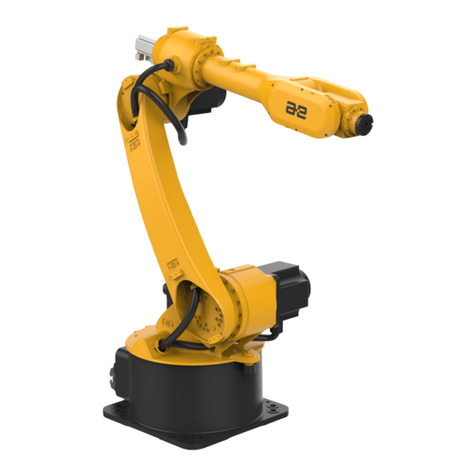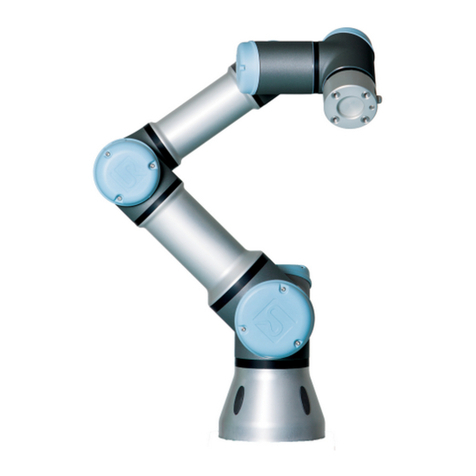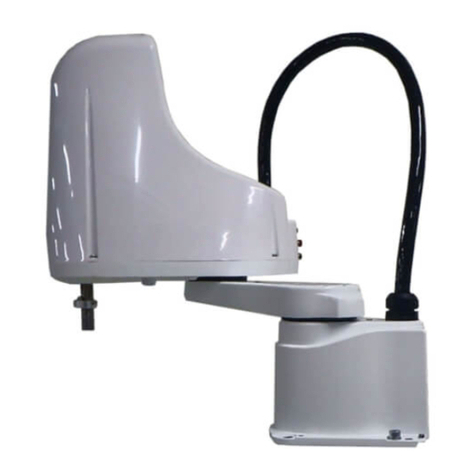Hyundai HX200L User manual

Hyundai Robot
Manipulator Maintenance Manual
- HX200L , HX200L-2000,
- HX300 , HX300L,
- HX400
HX300060301MME2

The information presented in the manual is the property of HHI
Any copy or even partial is not allowed without prior written authorization from
HHI
It may not be provided to the third party, nor used for any other purposes
HHI reserves the right to modify without prior notification
Printed in Korea - Oct 2005 1st Edition
Copyright ⓒ 2005 by Hyundai Heavy Industries Co , Ltd

i
Contents
1 Safety 1-1
1.1. Introduction............................................................................................1-2
1.2. Relevant Safety Regulations .................................................................1-4
1.3. Safety Training.......................................................................................1-4
1.4. Safety Related Nameplate.....................................................................1-5
1.4.1. Safety arking....................................................................................1-5
1.4.2. Safety Nameplate ...............................................................................1-6
1.5. Definition of Safety Functions ................................................................1-7
1.6. Installation .............................................................................................1-8
1.6.1. Safety Fence.......................................................................................1-8
1.6.2. Placement of Robot & Peripheral Equipment....................................1-10
1.6.3. Installing the Robot ...........................................................................1-12
1.6.4. Space for Robot Installation ..............................................................1-14
1.7. Safety Operation for Robot Handling...................................................1-15
1.7.1. Safety Precautions for Robot Handling.............................................1-15
1.7.2. Safety Precautions for Operating Test..............................................1-18
1.7.3. Safety Precautions for Automatic Operation.....................................1-19
1.8. Safety Precautions for Access to Safety Fence...................................1-20
1.9. Safety Precautions for aintenance and Repair..................................1-21
1.9.1. Safety Precautions for Hi4a Controller aintenance and Repair...... 1-21
1.9.2. Safety Precautions for Robot System & anipulator aintenanace.1-22
1.9.3. Necessary Actions after aintenance and Repair ............................1-23
1.10. Safety Functions................................................................................1-24
1.10.1. Operating a Safety Circuit...............................................................1-24
1.10.2. Emergency stop..............................................................................1-26
1.10.3. Operating Speed.............................................................................1-29
1.10.4. Connecting the Safety Devices.......................................................1-29
1.10.5. Restricting the working Envelope....................................................1-30
1.10.6. onitoring Function ........................................................................1-30
1.11. Safety Related to End Effectors.........................................................1-31
1.11.1. Gripper............................................................................................1-31
1.11.2. Tool / Workpiece..............................................................................1-32
1.11.3. Pneumatic and Hydraulic Systems .................................................1-32
1.12. Liabilities............................................................................................1-33
2 Specifications 2-1
2.1. Robot achinery Part ............................................................................2-2
2.2. Location of Robot Identification Plate ....................................................2-3
2.3. Basic Specifications...............................................................................2-4
2.4. Robot Dimension and Working Envelope ..............................................2-6
1. Safety
2. Specifications

Contents
ii
2.5. Axis Identification.................................................................................2-11
2.6. Details of Wrist Axis Attachment Surface ............................................2-12
2.7. Details of Upper 1st AR Attachment Surface.....................................2-13
2.8. Application Wiring and Inspection Wiring Diagram ..............................2-14
2.8.1. Details of Customer Application Connectors.....................................2-15
2.9. Restricting the Working Envelope........................................................2-16
2.9.1. Axis 1(Axis S)....................................................................................2-16
3 Instructions 3-1
3.1. Robot Component Name .......................................................................3-2
3.2. Location of Safety Nameplate................................................................3-3
3.3. How to operate ......................................................................................3-4
3.3.1. Using Crane........................................................................................3-4
3.3.2. Using Forklift Truck .............................................................................3-6
3.4. How to Install .........................................................................................3-7
3.4.1. Operating Conditions ..........................................................................3-7
3.4.2. Installating the Robot anipulator ......................................................3-8
3.4.3. Dimension of Installation Surface .......................................................3-9
3.4.4. Accuracy of Installation Surface........................................................3-10
3.5. Allowable Load of Wrist Axis................................................................3-11
3.6. Recommended Standy Posture...........................................................3-16
4 Inspection 4-1
4.1. Inspection Item and Period ....................................................................4-2
4.2. Inspection Item and Period ....................................................................4-3
4.3. Inspection of ain External Bolts...........................................................4-5
4.4. Inspection of Wrist Backlash..................................................................4-7
4.5. Inspection Internal Wiring ......................................................................4-8
4.5.1. The Conditions of Safety Inspection ...................................................4-8
4.5.2. Inspection Part....................................................................................4-9
5 Maintenance 5-1
5.1. Grease Replenishment/Replacement....................................................5-2
5.1.1. S-Axis Reduction Gear .......................................................................5-3
5.1.2. H-Axis Reduction Gear .......................................................................5-4
5.1.3. V-Axis Reduction Gear .......................................................................5-6
5.1.4. R2-Axis Reduction Gear .....................................................................5-8
5.1.5. B-Axis Reduction Gear .......................................................................5-9
5.1.6. R1-Axis Reduction Gear ................................................................... 5-11
5.1.7. Bearing Joint Parts ...........................................................................5-13
3. Instructions
4. Inspection
5. Maintenance

iii
5.1.8. A1 Frame - Gear Box........................................................................5-14
5.1.9. Wrist - Gear Box ...............................................................................5-15
5.2. Battery Replacement ...........................................................................5-16
5.2.1. Instructions for Battery Storage.........................................................5-18
5.3. Internal Wiring......................................................................................5-19
5.3.1. Wiring Connection Diagram..............................................................5-20
6 Trobleshooting 6-1
6.1. Troubleshooting Procedure ...................................................................6-2
6.2. Trouble Symptoms and Possible Causes ..............................................6-3
6.3. Diagnostics and Resolutions for ajor Parts Failure .............................6-4
6.3.1. Fulcrum Bearings................................................................................6-4
6.3.2. Reduction Gear...................................................................................6-5
6.3.3. Brakes ................................................................................................6-7
6.3.4. otor ..................................................................................................6-8
6.3.5. Encoder ..............................................................................................6-9
6.4. otor Replacement .............................................................................6-10
6.4.1. Necessary Tools and Parts ...............................................................6-12
6.4.2. How to Replace otor ......................................................................6-13
6.5. Encoder Zero Setting...........................................................................6-15
6.5.1. Zero Setting ......................................................................................6-16
6.5.2. Encoder Reset..................................................................................6-17
6.5.3. Confirming the Reset ........................................................................6-19
6.5.4. Encoder Calibration(Data input) and Selection.................................6-20
7 Recommended Spare Parts 7-1
8 Internal Wiring Diagram 8-1
8.1. anipulator Configuration......................................................................8-2
8.2. Wiring Diagram......................................................................................8-3
9 Decommissioning 9-1
6. Troubleshooting
7. Recommended Spare Parts
8. Internal Wiring Diagram
9. Decommissioning

Contents
iv
List of Figures
Fig 1.1 Recommended Size for Fence and Gate Hole (Square Gate)......... 1-8
Fig 1.2 Recommended Size for Fence and Gate Hole (Slot Gate) .............. 1-8
Fig 1.3 Placement of Peripheral Equipment and Operator ........................ 1-10
Fig 1.4 Space for robot installation............................................................. 1-14
Fig 1.5 Robot’s Safety Circuit .................................................................... 1-24
Fig 1.6 Emergency Stop ............................................................................ 1-27
Fig 1.7 Emergency Stop Connection of External System .......................... 1-28
FIg 2.1 Robot achinery Part...................................................................... 2-2
Fig 2.2 The location of identification plate.................................................... 2-3
Fig 2.3 Robot Dimension and Working Envelope : [HX300] ........................ 2-6
Fig 2.4 Robot Dimension and Working Envelope : [HX400] ........................ 2-7
Fig 2.5 Robot Dimension and Working Envelope : [HX200L]....................... 2-8
Fig 2.6 Robot Dimension and Working Envelope : [HX200L-2000] ............. 2-9
Fig 2.7 Robot Dimension and Working Envelope : [HX300L]..................... 2-10
Fig 2.8 Robot Dimension and Axis [HX300/400/200L/200L-2000/300L].....2-11
Fig 2.9 Details of Wrist Axis Attachment Surface : [HX300/400/300L] ....... 2-12
Fig 2.10 Details of Wrist Axis Attachment Surface : [HX200L] ................... 2-12
FIg 2.11 Details of Upper 1st AR Attachment Surface............................. 2-13
Fig 2.12 Application Wiring and Inspection Wiring Diagram ...................... 2-14
Fig 2.13 Details of Application Connector (Encoder) ................................. 2-15
Fig 2.14 Details of Application Connector (Power)..................................... 2-15
Fig 3.1 Identification of Robot Components................................................. 3-2
Fig 3.2 Location of Safety Nameplate.......................................................... 3-3
Fig 3.3 How to Transport: Using crane [HX300/400].................................... 3-4
Fig 3.4 How to Transport: Using crane [HX200L/300L]................................ 3-5
Fig 3.5 How to Transport : Using Forklift Truck
[HX300/400/200L/200L-2000/300L] .............................................. 3-6
Fig 3.6 Dimension of Robot Installation..................................................... 3-9
Fig 3.7 Accuracy of Installation surface ..................................................... 3-10
Fig 3.8 Wrist Axis Torque apping:[HX300/300L]...................................... 3-14
Fig 3.9 Wrist Axis Torque apping : [HX400]............................................. 3-14
Fig 3.10 Wrist Axis Torque apping : [HX200L]......................................... 3-15
Fig 3.11 Recommended Standby Posture ................................................. 3-16
Fig 4.1 Inspection Part for ain Bolts [HX300/400/300L] ............................ 4-6
Fig 4.2 Abnormal Backlash Inspecting Directions........................................ 4-7
Fig 4.3 Cable Inspection Parts : [HX300/400/200L/200L-2000/300L].......... 4-9
Fig 5.1 Explains of internal wiring .............................................................. 5-20
Fig 5.2 Wiring connection diagram : [HX300/400/200L/200L-2000/300L].. 5-21
Fig 6.1 How to prevent dropping of AR Axis H & V ..................................6-11
List of Figures

v
Fig 6.2 Encoder Reset Connector.............................................................. 6-18
Fig 8.1 anipulator Configuration................................................................ 8-2
Fig 8.2 otor and Brake wiring connection No.1 ......................................... 8-3
Fig 8.3 otor and Brake wiring connection No.2 ......................................... 8-4
Fig 8.4 Encoder wiring Connection No.1 ..................................................... 8-5
Fig 8.5 Encoder Wiring Connection No.2..................................................... 8-6
Fig 8.6 Encoder Wiring Connection No.3..................................................... 8-7
Fig 8.7 Application Wiring Connection No.1................................................. 8-8
Fig 8.8 Application Wiring Connection No.2................................................. 8-9
List of Tables
Table 1-1 Safety marking ............................................................................. 1-5
Table 1-2 State of robot stop...................................................................... 1-17
Table 2-1 Basic Specifications for odels.................................................... 2-4
Table 2-2 Axis otion..................................................................................2-11
Table 3-1 Components name....................................................................... 3-2
Table 3-2 Allowable load weight..................................................................3-11
Table 3-3 Allowable Load Torque................................................................3-11
Table 3-4 Allowable oment of Inertia....................................................... 3-12
Table 4-1 Inspection Schedule..................................................................... 4-2
Table 4-2 Inspection Items and Periods....................................................... 4-3
Table 4-3 Inspection part for main bolts ....................................................... 4-5
Table 6-1 Trouble phenomenon and cause.................................................. 6-3
Table 6-2 otor Weight.............................................................................. 6-10
Table 6-3 Necessary Tools......................................................................... 6-12
Table 6-4 Necessary parts ......................................................................... 6-12
Table 6-5 Reset connectors corresponding to axes................................... 6-17
Table 6-6 Data range after resetting .......................................................... 6-20
Table 7-1 Spare Parts ListⅠ........................................................................ 7-2
Table 7-2 Spare Parts ListⅡ........................................................................ 7-4
Table 7-3 Spare Parts List Ⅲ...................................................................... 7-5
Table 7-4 Spare Parts List Ⅳ...................................................................... 7-6
Table 7-5 Spare Parts List Ⅴ...................................................................... 7-7
Table 9-1 aterials of each part................................................................... 9-2
List of Tables


1. Safety
1-1
1 Safety
1
Safety

HX200/HX200L-2000/HX300/HX300L/HX400
1-2
1
Safety
1 1 Introduction
The main purpose of this chapter is to describe the safety precautions for users and
operators who repair and manipulate the industrial robot.
This manual describes safety precautions for robot manipulator and controller, in
comply with the requirement of ANSI/RIA R15.06-1999, Standard for Safety,
Industrial Robots, and qualified with safety regulations. The technical description and
installation method of robot system is presented in detail at the specifications
regarding installation of robot manipulator and controller.
Every operator, who installs, replaces, adjusts, manipulates, maintains, and repairs,
must read thoroughly and fully understand the manipulation and maintenance
manual, in particular, the special attention must be paid to the WARNING symbol, the
most important marking related to the safety.
Installation, replacement, adjustment, manipulation, maintenance, and repair of robot
system must be performed by the personnel who was duly trained for these purposes,
following the indicated operating procedure.
This company is planning and carrying out the relevant training such as maintenance,
repair, and manipulation for the above operations, so robot users make sure that
robot operators should get the relevant training. And make sure that the robot
handling work should be carried out only by the operators who completed this
training course.
The Users of HR and HX industrial robots have a responsibility under the safety
relavant regulations valid in the country where the robot is installed, and a
responsibility to properly design, install, and operate the safety devices to protect
workers.
The dangerous zone of robot system, that is the working range in which the robot,
tool, and peripheral equipment are operated, must be safeguarded to prevent
workers or objects from entering the zone. If a person or object should nevertheless
enters the dangerous zone, make sure that the robot system is immediately shut
down by emergency stop system. The operators of robot system have a
responsibility to take all necessary steps to make correct installation, examination
and operation of the relevant safety devices.
This manual is provided for the utilization of HR and HX Series anipulator models
and Hi4a controller.
Valid application and invalid environment of HR and HX Series robots are as follows.
Application

1. Safety
1-3
It is applied to the 6-axis industrial robot used by installing on the surface of wall or
plane (axes addable). It is also appropriate for controlling operation in the dotted
section or consecutive section.
ajor application is
Spot welding
Handling
Assembly
Application such as Sealing
IG/ AG welding
Palletizing
Grinding
For the other use than the above emergency application, make a contact with our
company to consult on the robot use and possible applications.
Invalid environment
Our robot must not be used in a highly explosive environment and the areas
contaminated by oil, flammable materials or chemical materials. (Prohibited to be
installed and manipulated.)

HX200/HX200L-2000/HX300/HX300L/HX400
1-4
1 2 Relevant Safety Regulations
The robot is designed as per ISO10218.Jan. 1992 , safety standards for industrial
robots, and furthermore in comply with ANSI/RIA 15.06-1999 regulations.
1 3 Safety Training
All the personnel who intend to teach, operate or inspect the robot must be trained in
an approved robotic operation and safety training course before start-up. The safety
training course includes the following details:
Purpose and functions of safety devices
Safety procedure to handle the robot
Performance of robot or the robot system and possible hazards
Tasks associated with any specific robot applications
Safety concepts, etc.

1. Safety
1-5
1 4 Safety Related Nameplate
1 4 1 Safety Marking
For the purpose of effective safety instructions, the following safety symbols are used
in this manual.
Table 1-1 Safety marking
Symbols Descrptions
Warning
Indicate a potentially hazardous situation which, if not
avoided, could result in death or serious injury to
personnel and damage to equipment. The special
attention must be paid to the operation and handling.
Mandatory
Indicate the compulsory measures that should be
performed.
Prohibited
Indicate the prohibited actions and/or operations that
should not be performed.

HX200/HX200L-2000/HX300/HX300L/HX400
1-6
1 4 2 Safety Nameplate
Identification plates, warning label and safety symbols are attached to the robot and
to the inside and outside of control panel. The designation labels and cable ark for
wire harness between the robot and control panel, and the cables inside/outside of
control panel are provided.
All of these plates, labels, symbols and marks constitute safety-relevant parts of the
robot and the control panel. They must remain attached to the robot manipulator and
control panel at their clearly visible positions all the time for the safety and their full
performance.
The painted markings on the floor and signs indicating dangerous zones must be
clearly distinguished in form, color, and style from other markings on the machine
near the robot system or inside the plant facilities where the robot system is installed.
It is forbidden to remove, cover, or paint over by way of spoiling the
clearly visible identification plates, warning labels, safety symbols,
designation labels and cable marks

1. Safety
1-7
1 5 Definition of Safety Functions
Emergency Stop Function - IEC 204-1,10,7
There is one emergency stop button on the controller and teaching pendant
respectively. If necessary, additional emergency buttons should be able to connected
to the robot's safety chain circuit. The emergency stop function, which overrides all
other robot controls, stops all moving parts by disconnecting power supply, and
removes drive power to prevent the use of other dangerous functions controlled by
the robot.
Safety Stop Function - ISO 10218(EN 775),6 4 3
When a safety stop circuit is provided, each robot must be delivered with the
necessary connections for the safeguards and interlocks associated with this circuit.
The robot should have a number of electrical input signals which can be used to
connect external safety devices, such as safety gates, safety pads, and safety lamps.
These signals allow the robot's safety functions to be activated by all equipment,
including peripheral equipment and the robot itself.
Speed Limiation Function - ISO 10218(EN 775),3 2 17
In a manual mode, the speed of robot is strictly limited to 250 mm per second as
maximum.
The speed limitation applies not only to the TCT(Tool Coordinate Time), but to all
parts of manual mode robot. The speed of equipment mounted on the robot should
be possibly monitored.
Restricting working Envelope - ANSI/RIA R15 06-1999
The working envelope of robot axes should be restricted using software limits.
Axis 1,2, and 3 can also be restricted by means of mechanical stopper.
Operation Mode Selection - ANSI/RIA R15 06-1999
The robot must be operated either manually or automatically. In a manual mode, the
robot must be operated only by using the teach pendant..

HX200/HX200L-2000/HX300/HX300L/HX400
1-8
1 6 Installation
1 6 1 Safety Fence
Install safety fence against the possible collision between the robot and workers, so
that no worker may approach the robot .When operators or other personnel enter the
robot's working envelope by accident, it may cause an accident. Install the safety
fence to stop the robot when one, who intends to replace for TIP DRESSING or TIP
replacement, or to inspect welding equipment, opens the fence gate and approaches
the equipment during operation.
4.9cm (1.875") ax
0.3m (12") ax
1.5m (60") in
4.9cm (1.875") ax
Fig 1.1 Recommended Size for Fence and Gate Hole (Square Gate)
0.3m (12") ax
1.5m (60") in
4.9cm(1.875") ax
Fig 1.2 Recommended Size for Fence and Gate Hole (Slot Gate)
① Install the safety fence to cover the robot’s working envelope and to secure
enough space for teaching and maintenance working. The safety fence
should also be firmly installed so that it is hardly accessible and removable.

1. Safety
1-9
② The safety fence should be a fixed type in principle, using harmless materials
that do not have any broken surface or projecting part.
③ Install the safety fence with an entrance gate, and register the safety plug at
the gate so that it does not open unless pulling the plug out. Interlock the
robot to be OTORS OFF when the safety plug is pulled out., or wire the
robot to be OTORS OFF when the safety fence is open. (Refer to “11.
Connecting the Other Signals”, Hi4a Controller anual)
④ When intending to operate the robot with the safety plug pulled out, wire the
robot as a low-speed play mode. (Refer to “11. Connecting the Other Signals”,
Hi4a Controller anual)
⑤ For immediate emergency stop, install emergency stop button wihin
operator’s easily accessible distance.
⑥ If the safety fence is not installed, install other devices substituting for the
safety plug in the whole place within the robot’s working envelope, such as
photoelectric switch and mat switch. These devices may stop the robot
automatically when a person enters the working envelope.
⑦ The robot’s working envelope(dangerous zone) should be distinguished from
other zones by painting its floor.

HX200/HX200L-2000/HX300/HX300L/HX400
1-10
1 6 2 Placement of Robot & Peripheral Equipment
(1) ake sure that the power supply is off before operating, when connecting the
primary power of controller or peripheral equipment. There is a possible
danger of electric shock because the high voltage such as 220V and 440V is
used as its primary power.
(2) Post a sign [No enter during operation] up the safety fence gate, and inform
the operators of its purport.
Interlocked Barrier Guard
110 cm(44") in
Restricted
space
aximum
space
110 cm(44") in
110 cm(44") in
Operator
Safeguarded
space
Controller
Fig 1.3 Placement of Peripheral Equipment and Operator
(3) Arrange such devices as controller, interlock panel, and other manipulation
panels to be handled outside of the safety fence.
(4) When installing operation stand, install the emergency stop button on the
stand. ake sure that the stand stops in an emergency wherever the robot is
handled.

1. Safety
1-11
(5) ake sure that the robot manipulator and the wiring and piping of controller,
interlock panel, and timer should not be placed in the way of operator's
working range so that they would not be directly stepped on by FORK and
LIFT. There is a possible danger of accident if the workers are affected by
electricity or the wiring is down.
(6) Place the controller, interlock panel, and handling stand within the sight of
robotic performance. It may cause a serious accident to operate the robot
while the operator is working, or the robot is malfunctioning in an invisible
sight.
(7) Restrict the robot's working envelope by using soft limits and mechanical
stopper if the necessary working envelope is narrower than the holding
workable envelope. It is possible to stop the robot in advance when it moves
beyond its normal working envelope due to an abnormal condition. (Refer to
the 『Robot anipulator aintenance anual』.)
(8) Welding spatters directly on the operator or around him may cause burning or
fire. Install such devices as a glare shield or a cover in the full sight of
robot's working envelope.
(9) ake sure that the device indicating the robot's running condition whether
automatic or manual mode must be noticeable even in the far distance. In the
case of automatic start-up, warning with a buzzer or warning lamp is also
valid.
(10) ake sure that there is no projecting part in the robot's peripheral equipment.
Cover it, if necessary. It usually may cause an accident if the operator comes
in touch with it. And it may lead a serious accident if the operator is
astonished at the sudden movement of robot, and conducts it.
(11) Don't make the system designed to allow the workers to carry the Work in
and out using their hands through the safety fence. It could be a cause of
accident associated with compressing or amputating.

HX200/HX200L-2000/HX300/HX300L/HX400
1-12
1 6 3 Installing the Robot
Install the robot as per the planning and layout which has been previously reviewed
and studied for its optimized performance and functionality. In case of poor
conditions for robot installation, the serious problems can take place, including error
of relative position between robot and workpiece during operation, bad performance
quality of robot caused by vibration, shortening lifetime, and cause of serious
accidents. Thus, pay attention to the following precautions when installing the robot.
General Safety Precautions
(1) Design and install the robot system properly in compliance with laws,
regulations, and safety requirements valid in the country where the robot
system is installed.
(2) All the workers for the robot system must have the complete knowledge on
the information specified in the application and supplementary manual, and
proficiently operate and handle the industrial robot.
(3) Installation workers of robot must follow the safety instructions and apply
them to the installation when they face any safety problems.
(4) System provider must ensure that all the circuits utilizing safety functions
perfectly perform in a safe way.
(5) Install main power supply to be disconnected from outside of the robot’s
working envelope.
(6) System provider must ensure that all the circuits utilizing emergency stop
function perfectly perform in a safe way.
(7) For the immediate emergency stop, install emergency stop button within the
accessible distance for the operator.
Technical Safety Precautions
(1) Eliminate any interference with peripheral equipment considering the
dimension and working envelope.
(2) Avoid such places for installing which is directly exposed to the sun,
extremely humid, contaminated by oil or chemicals, and containing a large
amount of metal powder and explosive gas.
This manual suits for next models
4
Table of contents
Other Hyundai Robotics manuals
Popular Robotics manuals by other brands

YASKAWA
YASKAWA MOTOMAN-VA1400 instructions

Robosen
Robosen T9 PRODUCT SPECIFICATIONS AND QUICK START MANUAL
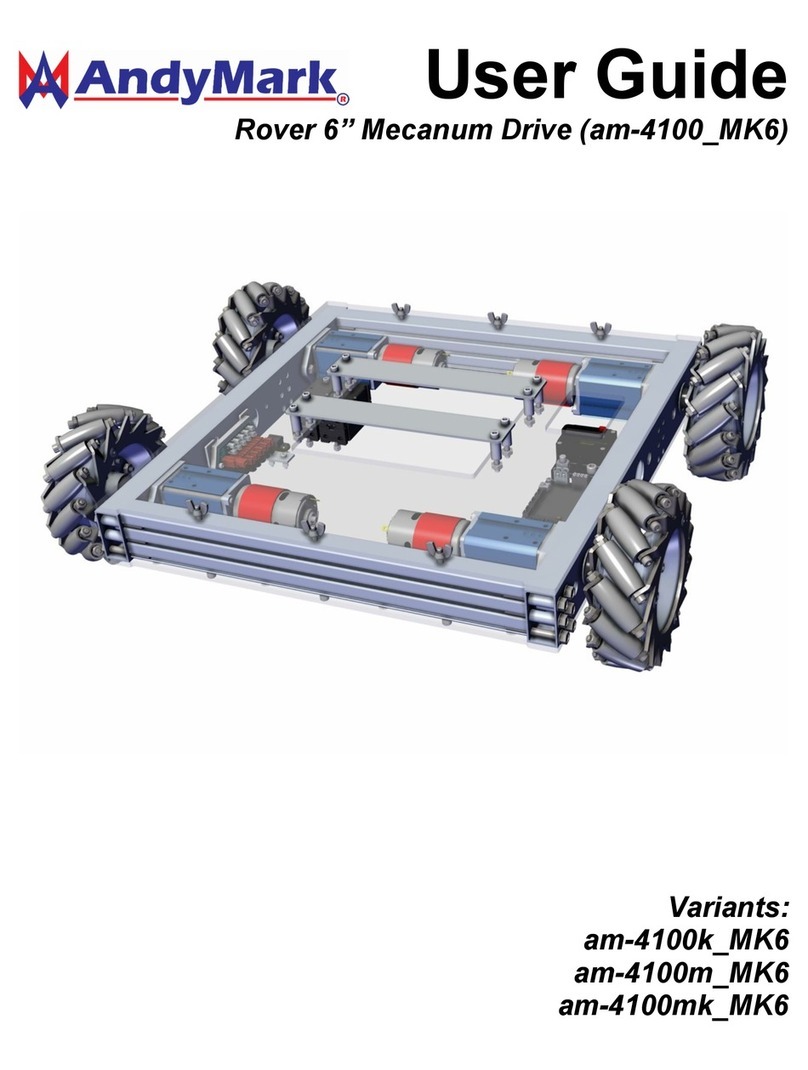
AndyMark
AndyMark Rover am-4100 MK6 Series user guide
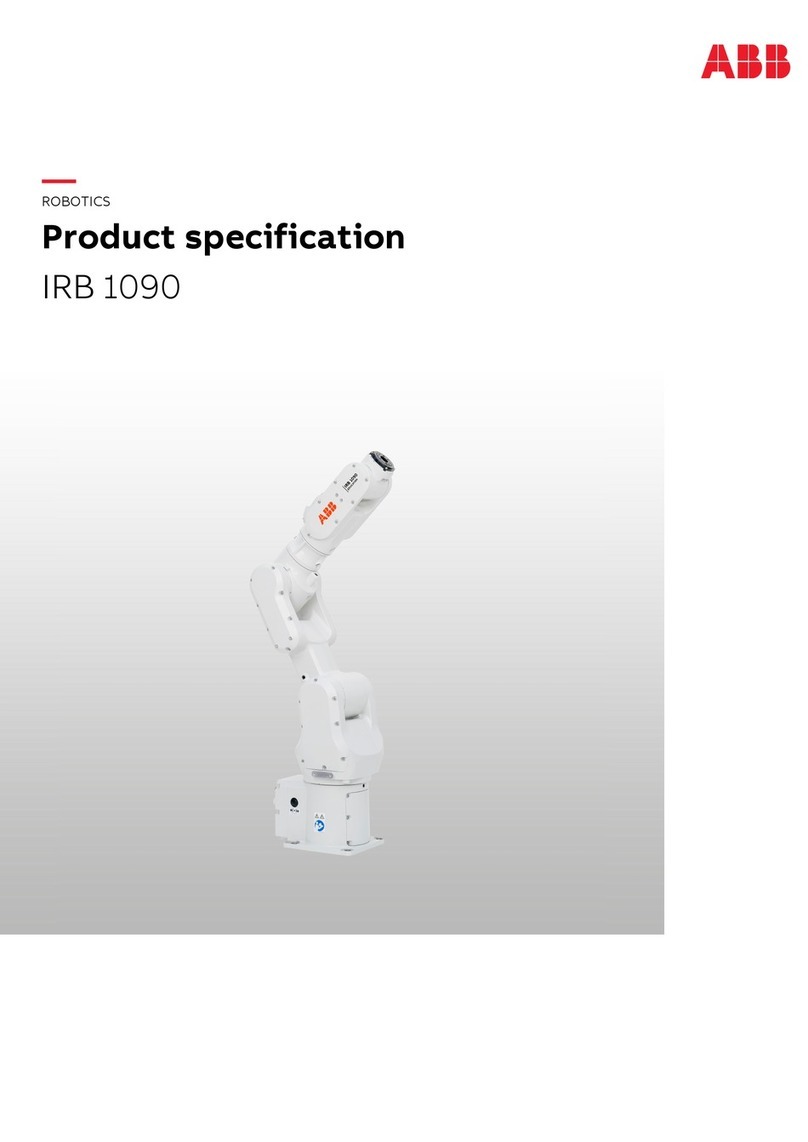
ABB
ABB IRB 1090 Product specification
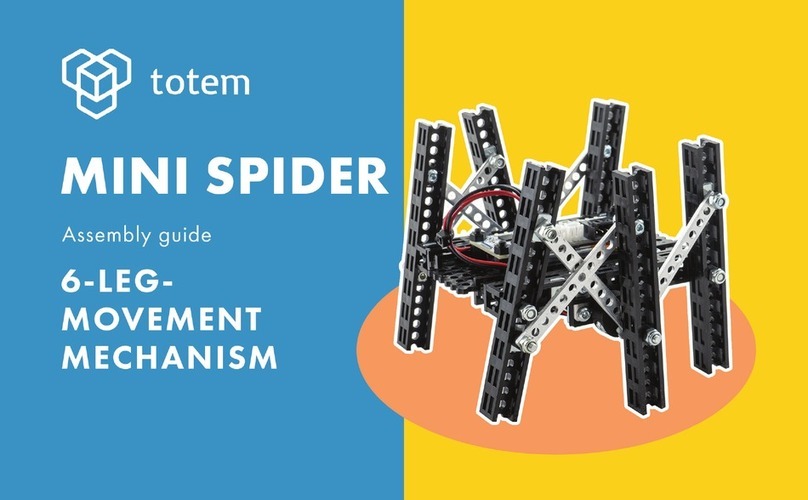
Totem
Totem MINI SPIDER Assembly guide

Evil Mad Scientist
Evil Mad Scientist WaterColorBot v 2.0 quick start guide

